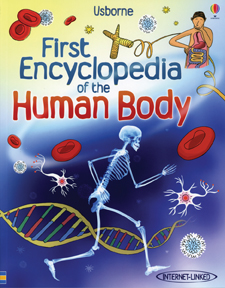The Usborne First Encyclopedia of the Human Body can be used with children about ages five through ten. Plenty of large, colorful illustrations show some details of human anatomy and selected functions of body systems.
The text is presented in brief paragraphs that often relate to familiar experiences. For example, it explains on page 25 that muscles give off heat when they work, and this is why we get hot when we exercise. Most of the content is ideal for children ages six through eight, but some of it will interest older children. With children on the younger end of the spectrum (about ages five and six), I would probably select only parts of the book to discuss particular topics that are appropriate for their level.
The sections on reproduction and maturation are very carefully handled to provide a limited amount of information that is appropriate for children. While it's not enough for those hitting puberty, it's sufficient for younger children.
There are a few activities in the book for children to try—e.g., feeling their muscles, a blindfolded test of their touch sensors, and seeing their breath on a mirror. The layout of the book makes it best for use as a read-aloud, with parents selecting the content to read and adding discussion and activities as needed.
The combination of brief snippets of information with intriguing illustrations makes this book an excellent introduction to the study of the human body.










